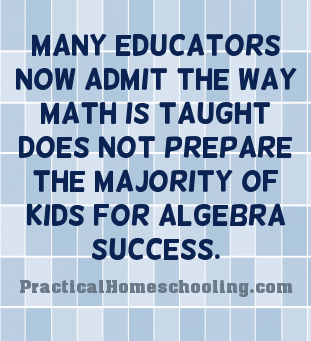Getting Ready for Algebra
By Bill Pride
Printed in Practical Homeschooling #84, 2008.
 Not everybody is ready for algebra when the time comes to take it. How can we get our student ready?
Not everybody is ready for algebra when the time comes to take it. How can we get our student ready?

|  |

| Catching Up Quickly
Doing algebra in eighth grade is fine . . . unless your student is about
to enter eighth grade and isn’t ready yet. He or she needs to come up to
speed quickly to be ready for algebra next school year.
Homeschoolers have a rich range of solutions to this problem. First, and
a Pride family favorite, is The Quarter Mile by Barnum Software
(www.thequartermile.com). This software uses a racing motif as the
setting for a student to learn math. A student races against his own
previous times, not other students, so there is no destructive
competition. He gets a feeling of progress, and can easily know when he
has reached a point of diminishing returns.
If you don’t have a computer, yet want the same kind of self-competitive
edge, you should try Calculadder (www.calculadder.com). These timed
worksheets are designed to take you through arithmetic from counting to
decimals and fractions.
For a less competitive, more workbook approach you can try Developmental
Math (www.mathplace.com). This sixteen-level series of workbooks covers
arithmetic from single digits through decimals.
Another publisher, Math Essentials (www.mathessentials.com), covers
upper-level arithmetic topics. They have two different workbook series:
a series of survey workbooks, including one for grades 4 and 5 and
another for middle school/high school; and a series of single topic
workbooks, one each for Whole Numbers and Integers, Decimals and
Percents, Fractions, Problem Solving, Pre-Algebra Concepts, and
Geometry.
The Key To series from Key Curriculum Press (www.keypress.com) offers an
alternative workbook series that not only reviews the more advanced
arithmetic topics: fractions, decimals, percents, and measurements, but
also goes on to cover geometry and algebra.
|
A new trend in math education may affect how you will need to pace your
children’s elementary math curriculum. It also affects their ability to
get into a good college.
In 1983 the National Commission on Excellence in Education published its
report on American education, A Nation at Risk. The report recommended
that all students, not just the gifted ones, take algebra and that they
take it early.
Many educators now admit the way math is taught does not prepare the
majority of kids for algebra success, except in a few excellent school
districts. Even so, rising state and local high-school standards have
increased the pressure on the high schools which, in their turn, now
expect more from the middle schools. As a result, beginning algebra is
being taught earlier, often in eighth grade, where it used to be taught
in ninth. Even this isn’t as early as in many Asian and European
countries, where algebra is often introduced as early as 7th grade.
To aid in achieving the goal of early algebra, school systems are
resorting to extraordinary measures. An Education Week article from
April 22, 2008, says, “From 1996 to 2005, the proportion of U.S.
students who reported taking Algebra 1 as 8th graders climbed from 24
percent to 34 percent, though the share varies enormously by state. . .
. Last year, for the first time, California state officials approved an
entire set of math programs devoted specifically to ’algebra readiness,’
or raising the skills of students likely to struggle in that subject.
Similar algebra-readiness materials are being used in other states and
districts around the country.”
You might suspect that pushing students to take algebra so early might
mean that they don’t learn as well, or that they burn out on math, but
according to Education Week, the opposite is true.
Completing introductory algebra, and doing so relatively early, benefits
students later on, research suggests. A 2005 federal study found that
more than 80 percent of students who took Algebra 1 as 9th graders went
on to complete Algebra 2 or an advanced math class, such as calculus,
during high school. Only 29 percent who did not follow that schedule
ended up finishing upper-level algebra or calculus.
Obviously, these statistics say that it is desirable for students who
take algebra to take it early. But can we expect everyone to be able to
pass basic algebra in eighth grade? For many, algebra is described as a
“psychological hurdle.” For those students the jump from the relatively
concrete mathematics of numbers to the abstract world of “x” and “y” is
one that modern elementary math programs have not prepared them to make
by eighth grade.
Algebra Readiness
For years the National Council of Teaching of Mathematics (NCTM) has
claimed it is far more important to teach children to “think like
mathematicians” than to teach them to solve arithmetic problems quickly
and accurately.
This approach has been great for teachers who are lousy at arithmetic,
but terrible for algebra readiness.
New strategies have been proposed to combat the problem. Just last month
the National Mathematics Advisory Panel (not related in any way to the
NCTM-it’s a panel created by the White House), called for “a more
logical progression” through the foundations of math. They singled out
whole numbers, fractions, geometry, and measurement, as pre-algebra
topics requiring a step-by-step, consistent approach.
This “new” strategy seems self evident. Really, what is the alternative
to a logical progression from one math concept to a more difficult one?
Homeschool math programs, such as Rod & Staff, Saxon, BJU Press, ABeka,
etc., take the methodical step-by-step approach and always have.
There are only two other ways to go. Either you teach the more difficult
stuff first, then the easy stuff, which is absurd, kind of like building
a house from the roof down to the foundation. Alternatively you try to
expose your student to everything at once, like building the house one
room at a time instead of laying a foundation and building up from
there. This is the “spiral” approach so common in modern textbooks. It
stuffs a potpourri of every kind of math into each year of the program
and increases the difficulty of each topic from year to year. This is
wasteful of precious teaching time.
A second strategy being proposed is using “visual reinforcements”-i.e.,
software, hands-on manipulatives, visual demonstrations, etc.-to clarify
the concepts being taught. These are all good ideas and again have been
available to homeschoolers for many years. Math-U-See (MathUSee.com) has
made extensive use of manipulatives in its program for many years (along
with its the textbooks and workbooks). They have added an online drill
area to their website as well. Others using similar manipulatives are
ETACuisenaire and Mortensen Math.
A third strategy is to abandon textbooks entirely (as too intimidating)
and go with packets of a week’s worth of materials at a time. At the end
of the week send the completed packet home or throw it out.
At home, inexpensive non-reusable workbooks may be an economical
alternative to weighty, intimidating textbooks.
Scope and Sequence
So what does your student need to know in order to be ready for basic
algebra? The answer in a word is “numbers.”
An algebra student has to be comfortable in the world of numbers, before
he crosses over into manipulating variables and dealing with more
complicated operations. There are two reasons for this: First, you never
leave numbers behind. You will still be adding, subtracting,
multiplying, and dividing numbers and you don’t want to get bogged down
in the arithmetic when you are supposed to be learning algebra. I had to
pause to teach fraction arithmetic to one of my community-college-level
intermediate algebra classes before I could go on to teach solving
equations.
Second, many of the manipulations you do with variables are analogous to
those you do with numbers. If you understand what you are doing with
numbers, you will more easily understand how to do it with variables.
So what do you need to know?
- Whole numbers.
Adding, subtracting, multiplying, dividing, raising
to powers.
- Fractions.
Greatest common divisor, simplifying, multiplying,
dividing, least common multiple, adding, subtracting.
- Decimals.
Adding, subtracting, multiplying, dividing, percents,
converting decimals to fractions and vice versa.
- Measurements.
English units, metric units, doing conversions from
one unit to another.
- Basic Geometry.
Regular polygons, perimeter, area, circles,
circumference and area.
- Basic Problem Solving.
Translating words, (sum, difference, product, ratio, twice as much, more
than, etc.), into numbers and symbols
If your students know all these things by the end of sixth or seventh
grade, they will have no trouble learning algebra in seventh or eighth
grade. Algebra will just be the next natural step toward mastering math.
| Textbook Math vs. Show-‘n’-Tell Math vs. Magazine Math
Modern math programs take one of three basic approaches to math:
textbook math, show-‘n’-tell math, or magazine math.
Textbook math is math that packages its curriculum in one fairly hefty
textbook, often with an associated student workbook. A textbook or
workbook that is thorough without being boring can make math fun. For
kids who like to have their work all down neatly on paper (or need to
learn to do so), this approach is the simplest and best.
Show-‘n’-tell math includes visual and hands-on aids, such as
manipulatives, videos, interactive CD-ROMs, etc., to enrich the math
experience.
While it is true that some programs overdo the use of manipulatives,
using tangrams, counters, attribute blocks, clocks, base ten blocks, and
dozens of others, a picture is still worth a thousand words and a
demonstration is worth even more. For a kinesthetic-tactile
learner-someone who learns by touch-it’s worth closer to a million
words.
A few well-chosen manipulatives can help make arithmetic more real for
your student. And most of the basic manipulatives are simple enough that
you can make them if you can’t afford to buy them.
Publishers of what we call magazine math programs festoon the pages of
their textbook with colorful articles about careers, biographies of
famous mathematicians, chatty word problems, etc.
The problem with this arrangement of materials is that it gives equal
prominence to material that is peripheral, at best, to the math being
learned. Enrichment material should be placed at the end of chapters or
even at the end of the book. Stringing “enrichment” and off-topic
materials throughout the text confuses the child about what he or she
needs to learn, and breaks the “flow” of step-by-step learning. My wife
calls these “Attention Deficit Disorder” texts, because they actually
encourage kids to skitter from topic to topic without concentrating
fully on any of them.
|
Bill Pride has a B.S. in mathematics from MIT and a M.A. in mathematics
from University of Missouri-St. Louis. He is currently studying toward
his Ph.D. in mathematics and teaching community-college math classes.